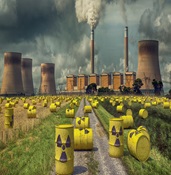Modelación de las concentraciones del contaminante dióxido de azufre emitido por dos calderas industriales en Santiago de Cali (Colombia)
Contenido principal del artículo
En el presente artículo aborda la modelación de las concentraciones de Dióxido de Azufre (SO2) emitidas por dos industrias ubicadas en la ciudad Santiago de Cali. Estas industrias emplean distintos tipos de combustible en sus calderas: la caldera 1 utiliza Fuel Oil y la caldera 2 utiliza Diésel. Con el objetivo de evaluar y comparar el comportamiento de las concentraciones de SO2, se propone la sustitución de estos combustibles por Gas natural. Mediante el uso de Aermod View se realizó la modelación de la dispersión de este contaminante y se obtuvo que para un tiempo de exposición de una hora la concentración máxima SO2 proveniente de las calderas con Fuel Oil y Diésel fue de 1440.32 µg/m3. Para un tiempo de exposición de 24 horas se alcanzó una concentración de SO2 de 178.56 µg/m3. Estos niveles, exceden los límites establecidos en la resolución 2254 de 2017, donde el valor máximo permisible para una hora es 100 µg/m3 y para 24 horas es 50 µg/m3. En contraste al usar Gas natural como combustible se observa que las concentraciones son considerablemente más bajas. Para un tiempo de exposición de una hora la máxima concentración es de 0.74 µg/m3 y para un tiempo de exposición de 24 horas, de 0.04 µg/m3. Estos resultados cumplen con la normatividad vigente. Se puede concluir que el Gas natural se presenta como una alternativa más favorable, generando concentraciones significativamente menores de SO2. Este cambio en el tipo de combustible no solo favorecerá el cumplimiento de las normativas ambientales, sino que también contribuirá de manera efectiva a la reducción de la concentración de SO2 en el aire.
- Calidad del aire
- Contaminación atmosférica
- Dispersión
- Espacialización de las emisiones
- Vista aérea
Valencia Zapata LM. Variation of atmospheric emissions generated by fixed sources within the jurisdiction of the Regional Autonomous Corporation of the Black River and Nare Basins - CORNARE: A strategy for efficient control and monitoring. 2019;
Grisales Vargas SC. Guidance report on the link between air pollution and climate change,
mitigation strategies for short-lived climate pollutants and their incorporation into regional planning processes. 2021;(2500238039).
Acosta Santos MC. Formulation of a Modeling Protocol for Dispersion of Atmospheric Pollutants By Means of a Mathematical Model, Gaussian Model. 2021.
Núñez V, Rodríguez R, Gómez L, Herrera I, Morales M. Influence on air quality of sulfur dioxide emissions from fixed agricultural sources in Villa Clara. 2019; Available from: http://cagricola.uclv.edu.cu
Córdova Mendoza P, Barrios Mendoza TO, Córdova Barrios IC. First characterization of pollutant emissions and air quality in Ica, Peru. Rev Cuba Química [Internet]. 2021;33(1):138–53. Available from: file:///C:/Users/Godoy/Desktop/Primera caracterización de emisiones contaminantes y calidad del aire en Ica.pdf
Sandoval Menses JX. Evaluation of the concentration of particulate matter (PM 2.5) and its relationship with respiratory diseases in the municipality of Sogamoso-Boyacá. 2020;
Ministerio del Medio Ambiente y Desarrollo Sostenible. Res 2254 De 2017. 2017. p. 11.
Vidal Daza OA, Perez Vidal A. Estimation of Dilution of Atmospheric Contaminants from Paper Factory Using the AERMOD Model. Ingeniería. 2017.
Frías López A, Barcia Sardiñas S. Atmospheric emissions inventory from main fixed source of Cienfuegos city. Rev Cuba Meteorol [Internet]. 2019;25. Available from: http://opn.to/a/LRird
Alcaldia de SaOperativos de control de emisiones atmosféricas generadas por fuentes fijas (chimeneas) en el area urbana del municipio de Santiago de Calintiago de Cali. Operations to control atmospheric emissions generated by fixed sources (chimneys) in the urban area of the municipality of Santiago de Cali. 1999.
Galvis Morales K, Torres García TM. Comparative analysis of PM2.5 concentrations in air quality monitoring stations in Bogota, Medellin and Cali, during the pre-pandemic and pandemic period August 2019 August 2020. 2020.
DAGMA. Monthly Bulletin of Air Quality and Environmental Noise of Santiago de Cali. 2019;1–34.
Intriago Panchano AJ, Gomez Andrade CX. Business plan on the import and sale of additives for petroleum products in the industrial sector. 2020.
Ecopetrol. Natural Gas. New York Times. 2020.
Alcaldia de Santiago de Cali. Operations to control atmospheric emissions generated by fixed sources (chimneys) in the urban area of the municipality of Santiago de Cali. 1999.
EPA. Air Quality Dispersion Modeling [Internet]. 2017 [cited 2023 September 30]. Available from: https://www.epa.gov/scram/air-quality-dispersion-modeling-preferred-and-recommended-models#aermod
Silva A, Arcos D. Aplicación del programa AERMOD para modelar dispersión de PM10 emitido por equipos de calefacción a leña en la ciudad de Constitución. Obras y Proy. 2011;(9):4–10. DOI: https://doi.org/10.4067/S0718-28132011000100001
Ecopetrol. Diésel. 2021
SRTM30 [Internet]. [cited 2023 November 8]. Available from: https://icesat.gsfc.nasa.gov/icesat/tools/SRTM30_Documentation.html
Ecopetrol. Fuel quality. [Internet]. 2022 [cited 2023 November 8]. Available from: https://www.ecopetrol.com.co/wps/portal/Home/sostecnibilidad/ambiental/aire-limpio/calidad-combustibles
Rangel Jiménez AE, Portilla Salazar CJ. The process of substitution of heavy fuels by natural gas in the industrial sector of Valle del Cauca and Cauca - Colombia 2004-2012. Apunt del Cenes. 2016;35(61):237–66. DOI: https://doi.org/10.19053/22565779.4148
Descargas

Esta obra está bajo una licencia internacional Creative Commons Atribución-NoComercial-CompartirIgual 4.0.
Los autores que publican en esta revista están de acuerdo con los siguientes términos:
Los autores ceden los derechos patrimoniales a la revista y a la Universidad del Valle sobre los manuscritos aceptados, pero podrán hacer los reusos que consideren pertinentes por motivos profesionales, educativos, académicos o científicos, de acuerdo con los términos de la licencia que otorga la revista a todos sus artículos.
Los artículos serán publicados bajo la licencia Creative Commons 4.0 BY-NC-SA (de atribución, no comercial, sin obras derivadas).





